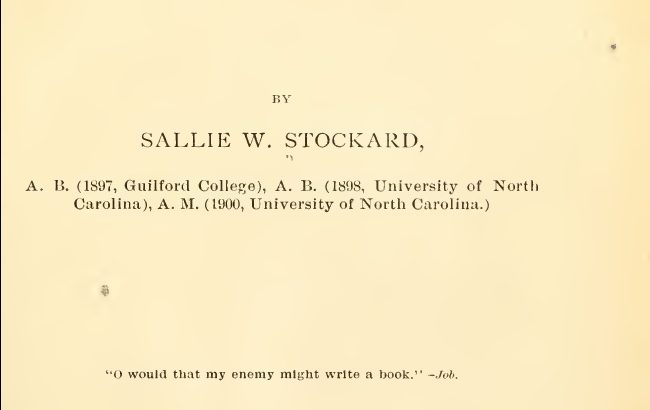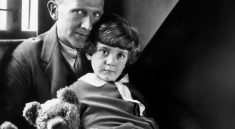Guilford County NC history, Settlement by Scotch-Irish German and English Quakers, First settlers came about 1749, Dissenters seeking religious liberty as well as homes
“In the history of Guilford County only four dates have any-
thing like a general value. These are: 1750, when the first settle-
ment was made; 1774, when the Quakers freed their slaves and
began to agitate the slavery question ; 1840, when the Whig idea
attained supremacy and the internal improvement and educational
wave began to break over the country; and 1865, the close of
the Civil War. Around these dates each of these ideas has
hovered like a shadow with a penumbra fainter and fainter in
effect.”…The History of Guilford County
From The History of Guilford County by Sallie Stockard.
The Settlement
"About 1749 the first settlers came to this section. At that time a heavy stream of migration was pouring into North Caro- Hna. In the portion of the State marked by the present towns of Greensboro, Sahsbury, Concord and Charlotte, the Scotch-Irish and German settled. To the territory now known as Guilford County people repre- senting three nations, the Scotch-Irish, the German exiles from the Palatine and the English Quakers, came. These people were dissenters seeking religious liberty as well as homes for wives and children. From the colony of William Penn, where they had first set foot on American soil, they passed on through Virginia, where the Church of England was already established, and traveled through a wild country to a milder climate and the freedom of forest and river to be found in Piedmont North Carolina. In the beautiful scope of country that later became Guilford County these three peoples settled, building their homes amid the fertile, rolling plains and wide ridges of IMiddle Carolina. The houses, manners and customs of the lands they had left were soon firmly fixed upon the new country. In central Guilford the Scotch-Irish settled ; in east Guilford the Germans built their homes ; while in west Guilford the English Quakers took up their abode. A band of Welsh also came to this section. In central Guilford were : the Archers, the Brannocks, the Caldwells, the Dennys, the Donnells, the Foulkes, the Gillespies, the Gorrells, the Htinters, the Kerners, the Lindsays, the McAdoos, the McjMikels, the Osbornes, the Stokes, the Sanders and the
Weatherlys. (Mr. Robert M. Sloan of Greensboro is authority for this.) In east Guilford were: the Albrights, the Clapps, the Cobbs, the Cobles, the Fousts, the Holts, the Keims, the Linebergers, the Sharps, the Shoffncrs, the Straders, the Summers, the Reitzells, the Whitsells, the Whitsetts and the Wyricks. In west Guilford were : the Armfields, the Seasons, the Chip- mans, the Coffins, the Elliotts, the Edwards, the Gardners, the Horneys, the Mendenhalls, the Pughs, the Starbucks, the Stan- leys, the Welborns. One band of Scotch-Irish came from Lancaster County, Penn- sylvania ; another poured into the province by way of Charleston^ South Carolina. These two streams met in central Guilford. A company called the Nottingham Company of Pennsylvania bought a large tract of land on the Buffalo and Reedy Fork Creeks. ( See Life of Caldwell.) These were the blue-stocking Presbyterians. On the headwaters of the Alamance the * followers of Whitfield built their homes. Old Alamance Church was the nucleus of the neighborhood. "From the stock of Scotch-Irish in the north of Ireland," say Hawks, Swain and Graham in their History of the Revolution, page 51, "came the Carolina immigrants. They reached the place of their settlement by two different avenues of approach ; the one portion came to America by the Delaware River, landing in Phila- delphia ; the other touched our shores at Charleston, South Caro- lina. They struck into the fertile country of Virginia, and in Carolina the two tides of migration met. The line of their settle- ments across the whole state from North Carolina to Virginia may be traced through Charlotte, Concord, Salisbury, Lexington, Greensboro, Milton and the head waters of the Roanoke." "Our forefathers," says Dr. C. H. Wiley in his address on the Centen- nial of Alamance Church, "came not as adventurers or hunters, not as outlaws and wanderers, but as intelligent men, with good
* These were Presbyterians who had been influenced to emotionalism by John Wesley.
worldly substance, with needed implements of industry, with civi- lization and the church." The characteristics of the Scotch-Irish are mainly noticeable in thought-movements. From this stock have come our public men, soldiers, politicians, statesmen, agitators. Morehead, Gilmer, Wiley were Scotch-Irish. In the first battle for American rights, that of Alamance, in 1771, and the last decisive battle of the Revo- lution, that of Guilford Courthouse, of 1781, the Scotch-Irish were most prominent. The Germans, who settled east of the Scotch-Irish, had come from the Palatine, driven by the scourge of war from what was once their happy home. Up the Rhine from Cologne the Thirty Years' War had left terrible devastation. Thousands of these people came to America upon William Penn's invitation. With them they brought that love of domestic life so marked a characteristic of the race. For many years their German speech excluded them from public offices, but they were among the fighters in the Regulation War and among the Whigs of the Revolution. Their manners and customs are German, their old German Bibles and text-books are extant. Unlike both German and Scotch-Irish was the Quaker in his territory in western Guilford. It is this element which makes the history of Guilford unique in North Carolina. The Scotch-Irish and German may be found in many other counties in the state ; but not these three together. In the conjunction of these a clash- ing of ideas came about which has made history. In the question of slavery Guilford County history is vital not only in this State but touches national life as well. The aggravating element kept the Scotch-Irish niind active. Out of the active Scotch-Irish mind came the impulse for internal improvements in North Carolina. In England, Quaker and Presbyterian had alike suffered re- ligious persecution. They were impelled by the same purpose to Note: In time of the Revolution and before it, William Rankin lived in Guilford on the North Buffalo; Walter Denny lived near by; Col. Daniel and Col. John Gillespie, Ralph Gorrell, Hantz McBride and John Thorn lived in the vicinity of Greensboro ; James Hunter, Robert Bruce, James Mendenhall and Henry Ballinger lived north and west of Greensboro
gain for themselves new homes and freedom to worship as they chose. About the same time, and probably together, they had journeyed to Guilford County. Though they had much in com- mon they w^ere yet unlike. In the Quaker settlement the hip-roofed houses and the various crafts are manifestations of English train- ing. Besides the Quakers who came from Pennsylvania about 1749, a band of Nantucket Quakers came to this territory in 1771 -J^ another band of emigrant Quakers came here from eastern North Carolina ; others still were of Welsh extraction. Among these last were the Benbows, Brittains, Hoskins and others. The followmg, taken from S. B. Weeks' "Southern Quakers," pages 107-108, gives us some interesting information concerning the Guilford County Quakers : ■'The island of Nantucket being small and its soil not very produc- tive, a large number of people could not be supported thereupon. The population of the island still increasing, many of the citizens turned their attention to other parts and removed elsewhere. A while before the Revo- lutionary War, a considerable colony of Friends removed and settled at New Garden, in Guilford County, N. C. William Coffin (1720-1803) was'' one of the number that thus removed about 1773. Obed Macy, writing of the period about 1760, says that because of the failure of the whale fishery some went to New Garden, N. C. About the outbreak of the Revolution, because of derangement of their business by the war, soine went to New York and North Carolina. "In 1764, Friends had begun investigations to find out who were the original Indian owners of their new homes, in order that they might pay them for the land, as they were trying to do at Hopewell, Va. It was reported that the New Garden section belonged to the Cheraws, who had been since much reduced and lived with the 'Catoppyes,' Catawbas. In 1780 two-thirds of the inhabitants of Nantucket were Quakers. Among their leaders were the Coffins, Starbucks, Folgers, Barnards, Husseys. "During a period of five years there were no less than forty-one cer- tificates recorded at New Garden Monthly Meeting from Nantucket out of a total of fifty certificates received. "In this number there were eleven families, including many that have since been prominent in Guilford County. Among them were : Libni Coffin, William Coffin, Jr., William, Barnabas, Seth (and wife), Samuel (and family), Peter and Joseph Coffin; Jethro Macy, David, Enoch, Na-
thaniel, Paul (and family), Matthew (and five children) and Joseph Macy; William,- Gayer, Paul (and family), and William Starbuck; Richard, Wil- liam, Stephen .and Stephen Gardner ; Tristrim, Francis and Timothy Bar- nard; Daniel, Francis and Jonah Worth; John Wickersham, William Reece, Jonathan Gifford, Reuben Bunker, Nathaniel Swain, Thomas Dixon." The Pennsylvania and Nantucket Quakers did not mingle and inter-marry with the Scotch-Irish, whose whole modus vivendi was the opposite of their own. Almost all the members of the denomination at the present day who are '"birth right," can trace their descent from one or both of these sources, and those who congratulate themselves upon their Nantucket origin may be interested in the following doggerel which was supposed tersely to describe those same ancestors. The Rays and Russells coopers are, The knowing Folgers lazy, A lying Coleman very rare, And scarce a learned Hussey, The Coffins noisy, fractious, loud. The silent Gardners plodding. The Mitchells good. The Bakers proud. The Macys eat the pudding, The Lovetts stalwart, brave and stern. The Starbucks wild and vain. The Quakers steady, mild and calm. The bwains sea-faring men, And the .I'olly Worths go sailing dowh the wind. In a letter of Tryon to the Board of Trade, August, 1766 (Col. Rec, Vol. 7, page 248), he said: "I am of opinion that this province is settling faster than any on the continent. Last autumn and winter upwards of one thou- Note: The greater portion of the county, even within our present boundaries, was at this time without white inhabitants. The beautiful middle region was the highway of traders from the eastern colonies of N. C. and Virginia with the Indians west and south. Dr. Wiley's address on Alamance Church, see also Records at Salisbury N. C, bks. 1-7, at Register's otfice. Guilford was a strategic point. Many of those who settled here afterwards went west.
sand wagons passed through SaHsbury with families from the northward, to settle in this province chiefly ; some few went to Georgia and Florida, but liked it so indifferently that some of them have since returned. "The dispatch of patents I have granted since my administra- tion will show to your Lordships the great increase of settlers in the western or back counties. These inhabitants are a people dif- fering in health and complexion from the natives in the maritime parts of the province, as much as a sturdy Briton differs from a puny Spaniard." Governor Tryon regarded this territory "as of great value, being perhaps the best lands on this continent, particularly Her- man Husbands', who had (in May, 1771) on his plantation about fifty acres of as fine wheat as perhaps ever grew, with clover meadows equal to any in the Northern Colonies." (Col. Rec, Vol. 8, page 615.) These people did not live in crude log cabins. Many of them had comfortable homes, hiproofed, with dormer windows, built of brick or frame material. They had wealth ; they loved beauty. All worked, continually stirring from four o'clock in the morning till late at night. Industry at length brought luxury and plenty. They were a pastoral and agricultural people such as good living never spoils, but, on the contrary, develops in them spirit and energy. Spacious fields of wheat, corn, buckwheat and patches of flax and cotton surrounded their homes. Sometimes a hundred bee hives added another charm to the garden, with its lilacs, roses, sweet lavender and daisies. The home itself was like a colony of bees in which there were no drones. It was a custom that no young woman should marry tmtil she possessed forty or more bed-quilts, counterpanes and Note: These Nantucket settlers were not the first Friends to come to North Carolina, and it is likely that Henry Phillips, who, in 1665, came to Albemarle from New England, was seeking a refuge from the tyranny of Massachusetts, where Friends suffered martyrdom on Boston Common.
snowy sheets that she had made herself. These articles of her handiwork she embroidered with all sorts of needlework. The women wove for the whole family, tow shirts, barndoor breeches and silken gowns. They sold great quantities of cloth, wagonloads of butter, cheese and honey. They raised silk, flax, cotton and wool, and manufactured these products for sale. They sold green apples and chestnuts all winter. People lived without much expense. They had no fear of work. The men prided themselves on their physical strength. A friendly fight as a test was not infrequent, while even old men wrestled occasionally. It was customary for a company of men and boys to collect on Saturday evenings at a mill or cross-roads. One described a circle. Upon banter being given two men stepped into the ring and they laughed at black eyes and hard knocks. They boxed each others' ears as a joke, and gouged and bit each other for fun."



